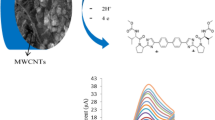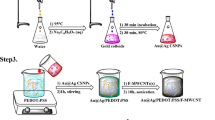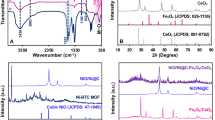Abstract
A highly sensitive electrochemical sensor is reported that employs a modified electrode for the precise measurement of cabotegravir, a potent anti-HIV drug. Cyclic voltammetry (CV), differential pulse voltammetry (DPV), and electrochemical impedance spectroscopy (EIS) were utilized for this purpose. Electrode modification involved the immobilization of Cr2AlC MAX phase/g-C3N4 onto a glassy carbon electrode (GCE) to enhance its electrocatalytic activity and selectivity for cabotegravir detection. Under the optimal experimental conditions, the working potential (vs. Ag/AgCl) was to 0.93 V. The developed sensor exhibited a good linear relationship in the range 0.05 µM to 9.34 µM with a low limit of detection of 4.33 nM, signifying its exceptional sensitivity. Additionally, it demonstrated successful cabotegravir detection in pharmaceutical formulations and biological samples, achieving an RSD below 3.0%. The recoveries fell within the range 97.7 to 102%, confirming the sensor's potential for real-sample applications. This innovative electrochemical sensor represents a significant advancement, providing a simple, reliable, and sensitive tool for the accurate measurement of cabotegravir. Its potential applications include optimizing drug dosages, monitoring treatment responses, and supporting the development of cabotegravir-based pharmaceutical products, thereby contributing to advancements in HIV therapy and prevention strategies.
Graphical Abstract











Similar content being viewed by others
Data availability
Data will be available on request.
References
Han Y, Mesplède T, Wainberg M (2015) Cabotegravir. HIV integrase inhibitor, anti-HIV agent. Drugs Future 40(11). https://doi.org/10.1358/dof.2015.040.11.2383040
Taki E, Soleimani F, Asadi A et al (2022) Cabotegravir/Rilpivirine: the last FDA-approved drug to treat HIV. Expert Rev Anti Infect Ther 20:1135–1147. https://doi.org/10.1080/14787210.2022.2081153
Prasanna A, Rani SS (2022) A Validated Stability Indicating RP-HPLC Method Development for Simultaneous estimation of Cabotegravir and Rilpivirine in Pharmaceutical Dosage form. World J Pharm Sci 22–29. https://doi.org/10.54037/WJPS.2022.101003
Blair HA (2022) Cabotegravir extended-release injectable suspension: A review in HIV-1 pre-exposure prophylaxis. Drugs 82:1489–1498. https://doi.org/10.1007/s40265-022-01791-3
Enggi CK, Isa HT, Wijaya S et al (2022) Validation of spectrophotometric method to quantify cabotegravir in simulated vaginal fluid and porcine vaginal tissue in ex vivo permeation and retention studies from thermosensitive and mucoadhesive gels. Spectrochim Acta Part A Mol Biomol Spectrosc 267:120600. https://doi.org/10.1016/j.saa.2021.120600
Pandya Y, Patel S RP-HPLC stability method development & validation for anti-HIV drugs cabotegravir & rilpivirine in IM injection and in human plasma. Int J Health Sci 9104–9117. https://doi.org/10.53730/ijhs.v6nS1.7056
Ramöller IK, Abbate MT, Vora LK et al (2022) HPLC-MS method for simultaneous quantification of the antiretroviral agents rilpivirine and cabotegravir in rat plasma and tissues. J Pharm Biomed Anal 213:114698. https://doi.org/10.1016/j.jpba.2022.114698
Bevers L, Kolmer EVEB, Te Brake H et al (2024) Development, validation and clinical implementation of a UPLC-MS/MS bioanalytical method for simultaneous quantification of cabotegravir and rilpivirine E-isomer in human plasma. J Pharm Biomed Anal 238:115832. https://doi.org/10.1016/j.jpba.2023.115832
Weld ED, Parsons TL, Gollings R et al (2023) Development and validation of a liquid chromatographic-tandem mass spectrometric assay for the quantification of cabotegravir and rilpivirine from dried blood spots. J Pharm Biomed Anal 228:115307. https://doi.org/10.1016/j.jpba.2023.115307
Boher S, Ullah R, Tuzen M et al. (2023) Metal doped nanocomposites for detection of pesticides and phenolic compounds by colorimetry: Trends and challenges. OpenNano 100168. https://doi.org/10.1016/j.onano.2023.100168
Gupta VK, Jain R, Radhapyari K et al (2011) Voltammetric techniques for the assay of pharmaceuticals—a review. Anal Biochem 408:179. https://doi.org/10.1016/j.ab.2010.09.027
Mehmandoust M, Khoshnavaz Y, Tuzen M et al (2021) Voltammetric sensor based on bimetallic nanocomposite for determination of favipiravir as an antiviral drug. Microchim Acta 188:1–15. https://doi.org/10.1007/s00604-021-05107-2
Khosrowshahi EM, Mogaddam MRA, Javadzadeh Y et al (2022) Experimental and density functional theoretical modeling of triazole pesticides extraction by Ti2C nanosheets as a sorbent in dispersive solid phase extraction method before HPLC-MS/MS analysis. Microchem J 178:107331. https://doi.org/10.1016/j.microc.2022.107331
Ismael M (2020) A review on graphitic carbon nitride (g-C3N4) based nanocomposites: synthesis, categories, and their application in photocatalysis. J Alloy Compd 846:156446. https://doi.org/10.1016/j.jallcom.2020.156446
Kokulnathan T, Wang T-J (2020) Vanadium carbide-entrapped graphitic carbon nitride nanocomposites: synthesis and electrochemical platforms for accurate detection of furazolidone. ACS Appl Nano Mater 3:2554–2561. https://doi.org/10.1021/acsanm.9b02618
Wang J, Yang B, Li S et al (2017) Enhanced photo-electrochemical response of reduced graphene oxide and C3N4 nanosheets for rutin detection. J Colloid Interface Sci 506:329–337. https://doi.org/10.1016/j.jcis.2017.07.059
Lei X, Lin N (2022) Structure and synthesis of MAX phase materials: a brief review. Crit Rev Solid State Mater Sci 47:736–771. https://doi.org/10.1080/10408436.2021.1966384
Wozniak J, Jastrzębska A, Olszyna A (2022) Challenges and opportunities in tailoring MAX phases as a starting materials for MXenes development. Mater Technol 37:1639–1650. https://doi.org/10.1080/10667857.2021.1968102
Zhu J, Ha E, Zhao G et al (2017) Recent advance in MXenes: a promising 2D material for catalysis, sensor and chemical adsorption. Coord Chem Rev 352:306–327. https://doi.org/10.1016/j.ccr.2017.09.012
Barsoum MW, El-Raghy T (2001) The MAX phases: Unique new carbide and nitride materials: Ternary ceramics turn out to be surprisingly soft and machinable, yet also heat-tolerant, strong and lightweight. Am Sci 89:334–343. https://www.jstor.org/stable/27857502
Low I-M (2012) Advances in science and technology of Mn+ 1AXn phases. Woodhead Publishing, Sawston, Cambridge
Zhang Z, Duan X, Jia D et al (2021) On the formation mechanisms and properties of MAX phases: A review. J Eur Ceram Soc 41:3851–3878. https://doi.org/10.1016/j.jeurceramsoc.2021.02.002
Fu L, Xia W (2021) MAX phases as nanolaminate materials: chemical composition, microstructure, synthesis, properties, and applications. Adv Eng Mater 23:2001191. https://doi.org/10.1002/adem.202001191
Hussein DR, Abbas KK, Abdulkadhim Al-Ghaban AM (2023) Overview in Technical Synthesis and Applications of Zr2AC (A= In, Sn, Pb, Al, S and Se) MAX phases: a brief review. Eng Technol J 41:1–15. https://doi.org/10.30684/etj.2022.136391.1313
Shahin N, Kazemi S, Heidarpour A (2016) Mechanochemical synthesis mechanism of Ti3AlC2 MAX phase from elemental powders of Ti, Al and C. Adv Powder Technol 27:1775–1780. https://doi.org/10.1016/j.apt.2016.06.008
Azina C, Badie S, Litnovsky A et al (2023) Optical properties and corrosion resistance of Ti2AlC, Ti3AlC2, and Cr2AlC as candidates for concentrated solar power receivers. Sol Energy Mater Sol Cells 259:112433. https://doi.org/10.1016/j.solmat.2023.112433
Champagne A, Battaglia J-L, Ouisse T et al (2020) Heat capacity and anisotropic thermal conductivity in Cr2AlC single crystals at high temperature. J Phys Chem C 124:24017–24028. https://doi.org/10.1021/acs.jpcc.0c08384
Lin Z, Zhou Y, Li M et al (2022) In-situ hot pressing/solid-liquid reaction synthesis of bulk Cr2AlC. Int J Mater Res 96:291–296. https://doi.org/10.3139/ijmr-2005-0051
Reghunath BS, Davis D, Devi KS (2021) Synthesis and characterization of Cr2AlC MAX phase for photocatalytic applications. Chemosphere 283:131281. https://doi.org/10.1016/j.chemosphere.2021.131281
Tang C, Große M, Ulrich S et al (2021) High-temperature oxidation and hydrothermal corrosion of textured Cr2AlC-based coatings on zirconium alloy fuel cladding. Surf Coat Technol 419:127263. https://doi.org/10.1016/j.surfcoat.2021.127263
Tian W, Wang P, Zhang G et al (2006) Synthesis and thermal and electrical properties of bulk Cr2AlC. Scripta Mater 54:841–846. https://doi.org/10.1016/j.scriptamat.2005.11.009
Ying G, He X, Li M et al (2011) Synthesis and mechanical properties of high-purity Cr2AlC ceramic. Mater Sci Eng, A 528:2635–2640. https://doi.org/10.1016/j.msea.2010.12.039
Sert B, Acet Ö, Noma SaA et al. (2023) A New Design to Enhance the Enzyme Activities: Investigation of L-Asparaginase Catalytic Performance by IMAC Effect on g-C3N4 Nanolayers. Catal Lett 1–11. https://doi.org/10.1016/j.msea.2010.12.039
Bouali W, Erk N, Genc AA et al. (2023) A new and powerful electrochemical sensing platform based on MWCNTs@ Fe3O4@ CuAl2O4 for the determination of the anticancer agent Alpelisib in bulk and biological fluids. Microchem J 109478. https://doi.org/10.1016/j.microc.2023.109478
Gonzalez-Julian J, Llorente J, Bram M et al (2017) Novel Cr2AlC MAX-phase/SiC fiber composites: Synthesis, processing and tribological response. J Eur Ceram Soc 37:467–475. https://doi.org/10.1016/j.jeurceramsoc.2016.09.029
Yembadi R, Panigrahi BB (2017) Thermodynamic assessments and mechanically activated synthesis of ultrafine Cr2AlC MAX phase powders. Adv Powder Technol 28:732–739. https://doi.org/10.1016/j.apt.2016.11.020
Gonzalez-Julian J, Onrubia S, Bram M et al (2018) High-temperature oxidation and compressive strength of Cr2AlC MAX phase foams with controlled porosity. J Am Ceram Soc 101:542–552. https://doi.org/10.1111/jace.15224
Bouali W, Erk N, Özalp Ö et al. (2023) Construction of a novel sensor based on activated nanodiamonds, zinc oxide, and silver nanoparticles for the determination of a selective inhibitor of cyclic guanosine monophosphate in real biological and food samples. Diam Relat Mater 110172. https://doi.org/10.1016/j.diamond.2023.110172
Acknowledgements
This work was supported by the Tarsus University Scientific Research Projects Coordination Unit (MF.23.008), the Scientific Research Projects Coordination Unit of Ankara University with the project number TSA-2023-2738, and the Scientific Research Project Office of Ankara University (A.Ü. BAP) (Project no: TDK-2023-3036/TDK-2023-3039/TDK-2023-3126).
Author information
Authors and Affiliations
Corresponding authors
Ethics declarations
Conflict of interest
The authors declare no competing interests.
Additional information
Publisher's Note
Springer Nature remains neutral with regard to jurisdictional claims in published maps and institutional affiliations.
Supplementary Information
Below is the link to the electronic supplementary material.
Rights and permissions
Springer Nature or its licensor (e.g. a society or other partner) holds exclusive rights to this article under a publishing agreement with the author(s) or other rightsholder(s); author self-archiving of the accepted manuscript version of this article is solely governed by the terms of such publishing agreement and applicable law.
About this article
Cite this article
Bouali, W., Genc, A.A., Erk, N. et al. Development of a Cr2AlC MAX phase/g-C3N4 composite-based electrochemical sensor for accurate cabotegravir determination in pharmaceutical and biological samples. Microchim Acta 191, 135 (2024). https://doi.org/10.1007/s00604-024-06207-5
Received:
Accepted:
Published:
DOI: https://doi.org/10.1007/s00604-024-06207-5




